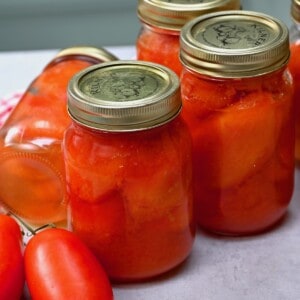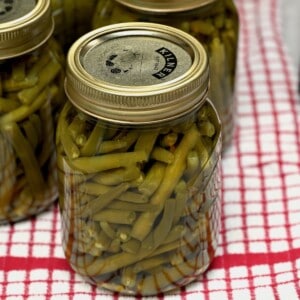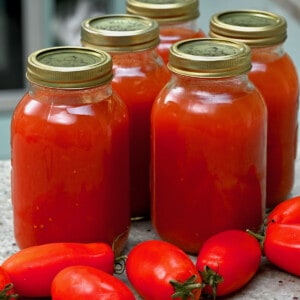This post may contain affiliate links. Please read our disclosure policy.
Learn how to can chickpeas and stock your pantry with these delicious legumes. Canning chickpeas will save you time and money—they are ready to use anytime you need them.

I love to stock my pantry with homemade essentials. You might have already seen me make canned whole tomatoes, vegetable bouillon cubes, or pickled cucumbers. Having all these prepped staples allows me to make delicious and wholesome dishes quickly without extra shopping or spending hours in front of the stove.
And since I’m a big fan of chickpeas and I cook dried chickpeas and freeze them all the time, I thought it was time to learn how to can them for an even longer shelf life.
The method for pressure canning chickpeas is simple—soak them, then transfer them to the jars and into the pressure canner for processing. I have added detailed instructions and photos below. For more tips, you can check out my complete guide to pressure canning.

Want to save this recipe?
Why can chickpeas at home?
Once you start canning dry chickpeas, you’ll never go back.
- Convenience: They are really so convenient! There’s no need to soak and cook them for hours. Canned chickpeas are ready to use! Use them for chickpea salad, chickpea soup, or creamy hummus—all in the time it takes to open the jar!
- You are in Control: You decide the ingredients—no added salt or unnecessary preservatives. You can season them as you want or leave them plain for flexibility in recipes. You are in complete control of how you want to prepare them.
- Better Taste and Texture: Home-canned chickpeas taste fresher and have a better texture compared to store-bought. And they will taste as you like them, already seasoned to your liking.
- Cost-Effective: Buying dried chickpeas is much cheaper than buying a can of chickpeas. Plus, by canning chickpeas at home, you can meal prep and plan for months in advance, saving you even more time and money!
Ingredients and tools needed
- Chickpeas: Use dried chickpeas (aka garbanzo beans).
- Salt: This is optional for extra flavor. Omit if preferred.
- Water.
Tools:
- A pressure canner with a canning rack.
- Glass jars with lids. I recomment 1 pint jars.
- A ladle or big spoon.
- A clean kitchen cloth (or paper towels) and white vinegar: These are essential to wipe the rims of the jars to ensure a proper seal, even if there’s minimal mess from the chickpeas.
- Optional but helpful tools: A canning funnel, canning tongs (jar lifter), bubble remover, magnetic wand, and jar wrench. These tools simplify the process, but household alternatives (like a knife for removing bubbles or large tongs for lifting jars) can also work.
- Jar labels or paper and tape for labeling.
See the printable recipe card below for full information on ingredients and quantities.
How to can chickpeas
Soak the chickpeas: Place the dried chickpeas in a large bowl filled with cold plain water. The chickpeas will double-triple in size while soaking, so make sure to cover them with plenty of water (at least 2-3 inches). Soak them for 12-24 hours.
Then, drain the soaking liquid and sort through the chickpeas, discarding any bad ones. Rinse the soaked chickpeas well under running water.

Gather the canning tools: While the chickpeas are soaking, toward the end of the time, gather all your canning tools. Inspect your jars for cracks or chips and the lids and bands for dents or rust. Make sure your pressure canner has a canning rack, and there are no obstructions on the vent pipe and gasket (rubber seal).

Prepare the equipment and your work surface: Wash everything thoroughly in hot, soapy water, including the jars, lids, and other canning tools. Rinse them well. Alternatively, you can use the dishwasher.
Then, place the clean jars in a large pot (or the canner) with boiling water for 10 minutes to sterilize them. If available, you can use the sterilization setting on your dishwasher. Keep the jars hot until you are ready to fill them.
Also, make sure to prepare your work surface. It’s best to use a large wooden board or to lay out a clean towel to avoid contact between the hot jars and a cold countertop. Finally, boil some fresh water.

Fill the jars: Using the jar lifter, take a sterilized jar and empty it of all the water. Place it on your work surface and position the canning funnel in the jar opening. Fill a 1-pint jar with 1 cup of soaked chickpeas, leaving about 1-inch headspace. Then add 1/4 teaspoon of salt.
Fill the jar with fresh boiling water, making sure to keep the 1-inch headspace. Then, using the bubble remover, remove the air bubbles and add a bit more water if necessary.
Next, wipe the jar rims with a clean kitchen cloth and white vinegar. While this step isn’t strictly necessary for chickpeas since they don’t leave much residue, it’s good practice to ensure a proper seal. Using the magnetic wand, position the lid on top of the jar, and then close the band finger-tight only.
Repeat until all the jars are filled with soaked chickpeas and their lids are closed.

Process the chickpeas: You will have to process the jars in your pressure canner according to your canner manual and your altitude. If you are preserving at an altitude higher than 1,000 feet above sea level, you will have to adjust the pressure pounds. For more information and to find your elevation, you can visit the official USDA Canning website.

To begin the canning process, place the canner on the stovetop. Then, fill it with the required amount of water (usually 2-3 inches, but make sure to check your manufacturer’s manual). Then, bring the water to a simmer (about 180ºF/82ºC).
Place the filled jars in the canner and make sure they don’t touch each other or the wall of the canner. Then, lock the canner lid but leave the weight off the vent pipe. Turn the heat to high and allow steam to flow from the vent pipe for 10 minutes.
After 10 minutes, close the vent or place the pressure regulator weight on the vent pipe. Monitor the pressure as it rises until it reaches the correct level for your altitude (minimum 10 PSI).
Start a timer when you have reached the proper pressure and process for 75 minutes for pint-sized jars (or 90 minutes for quart-sized jars). If needed, adjust the heat to maintain a steady pressure throughout the processing.
During processing, consistently monitor the pressure gauge. It needs steady pressure, and if it drops below the recommended level, you need to bring the pressure back and restart the timer.

Once the processing time is over, turn off the heat and allow the canner to depressurize naturally. Wait until the pressure gauge reads zero, and then wait an extra few minutes.
Then, carefully remove the weight from the vent pipe to make sure no steam remains. Wait another 10 minutes before finally unlocking and carefully removing the lid (make sure to tilt it away from your face).
Cool and store: Finally, remove the jars from the canner without tilting them. Place them on a flat surface and let them cool untouched for 12-24 hours.
On the next day, you can inspect the seals—the lids should be concave and not flex when pressed. If using removable bands, you can remove them. If any jars have not been canned properly, you can place them in the refrigerator and consume the chickpeas within a few days.
Then, label the jars with the contents and dates.
Store the canned chickpeas in a cool, dark place for up to 18 months. When you open a jar, make sure to listen for the popping sound—this indicates the canning was successful. Then, check for any signs of spoilage (visually and by odor). Finally, taste a few chickpeas, and if they are good, use them straight in your recipes!
Each pint jar will yield about 1.5 cups of cooked chickpeas. They are perfect for soups, stews, salads, hummus, and more!

More pressure-canned pantry items
If you try canning chickpeas at home, let me know how it goes in the comments below. I’d appreciate a recipe card rating and would love to see your recipe recreations – tag me on Instagram @Alphafoodie!

How to Can Chickpeas
Equipment
- 9 Glass jars 16 oz/1 pint each
- Bubble remover or chopstick, skewer, plastic/wooden knife, thin silicone/plastic spatula
- Microfiber cleaning cloth and some white vinegar to clean the jar rims
Ingredients
- 1.65 lb dried chickpeas more or less as wanted
- 2 ¼ tsp salt (1/4 tsp per pint jar)
- water to soak the chickpeas, to fill the jars, and to fill the canner
Instructions
Soak the chickpeas
- Soak the dried chickpeas in a large bowl with cold water for 12-24 hours. They will double in size.
- Drain the soaking water and sort through the chickpeas, discarding any that are bad. Rinse the soaked chickpeas well under running water.
Prepare the tools
- Inspect your jars for cracks or chips and the lids and bands for dents or rust. Make sure your pressure canner has a canning rack and that the vent pipe and gasket (rubber seal) are free of obstructions.
- Wash the jars, lids, and other canning tools thoroughly in hot, soapy water. Rinse them well.
- To sterilize the clean jars, place them in a large pot (or canner) with boiling water for 10 minutes. Keep them hot until you are ready to fill them.
- Boil some fresh water. Prepare your work surface by using a large wooden board or laying out clean towels.
Fill the jars
- Take a sterilized jar with the jar lifter and empty it of all the water. Place it on your work surface and position the canning funnel in the jar opening.
- Fill a 1-pint jar with 1 cup of soaked chickpeas, leaving about 1-inch headspace. Add 1/4 teaspoon of salt.
- Fill the jar with fresh boiling water, keeping the 1-inch headspace. Use the bubble remover to remove the air bubbles. Add some more water if needed.
- Wipe the jar rims with a clean kitchen cloth and white vinegar. Use the magnetic wand to position the lid on top of the jar, and close the band finger-tight only.
- Repeat the above steps until all the jars are filled and closed.
Process the chickpeas
- Place the canner on the stovetop and fill it with the required amount of water (usually 2-3 inches—check your manufacturer's manual). Bring the water to a simmer.
- Place the filled jars in the canner, making sure they don't touch each other or the wall. Lock the canner lid, but leave the weight off the vent pipe. Turn the heat to high and allow steam to flow from the vent pipe for 10 minutes.
- After 10 minutes, close the vent or place the pressure regulator weight on the vent pipe. Rise the pressure until it reaches the correct level according to your altitude (minimum 10 PSI).
- When you have reached the proper pressure, start a timer and process for 75 minutes for pint-sized jars (or 90 minutes for quart-sized jars). Adjust the heat to maintain a steady pressure throughout the processing if needed.Make sure to monitor the pressure gauge consistently—it needs steady pressure. If it drops below the recommended level, you need to bring the pressure back and restart the timer.
- Once the processing time is over, turn off the heat and allow the canner to depressurize naturally. Wait until the pressure gauge reads zero, and then wait an extra few minutes.
- Carefully remove the weight from the vent pipe to ensure no steam remains. Wait another 10 minutes before finally unlocking and carefully removing the lid (making sure to tilt it away from your face).
Cool and store the jars
- Remove the jars from the canner without tilting them. Place them on a flat surface and let them cool untouched for 12-24 hours.
- On the next day, you can inspect the seals—the lids should be concave and not flex when pressed. If using removable bands, you can remove them. Then, wipe the jars clean and label them with the contents and dates.
- Store the canned chickpeas in a cool, dark place for up to 18 months. Each pint jar yields about 1.5 cups of cooked chickpeas.
Notes
Nutrition
Nutrition information is automatically calculated, so should only be used as an approximation.













Very happy with how my chickpeas turned out. We had a hummus contest for Easter. They were all so different & unique I couldn’t pick a favorite. Can this recipe be used with other dried beans as well. I want to try kidney & black beans. Thanks!
Hi Lisa,
Thank you so much for your comment—a hummus contest sounds amazing!
While the canning process is quite similar between chickpeas and other beans, I recommend following a post specifically dedicated to canning beans to ensure you’re using the correct pre-cooking and processing steps.
Amazing tips! Thanks.